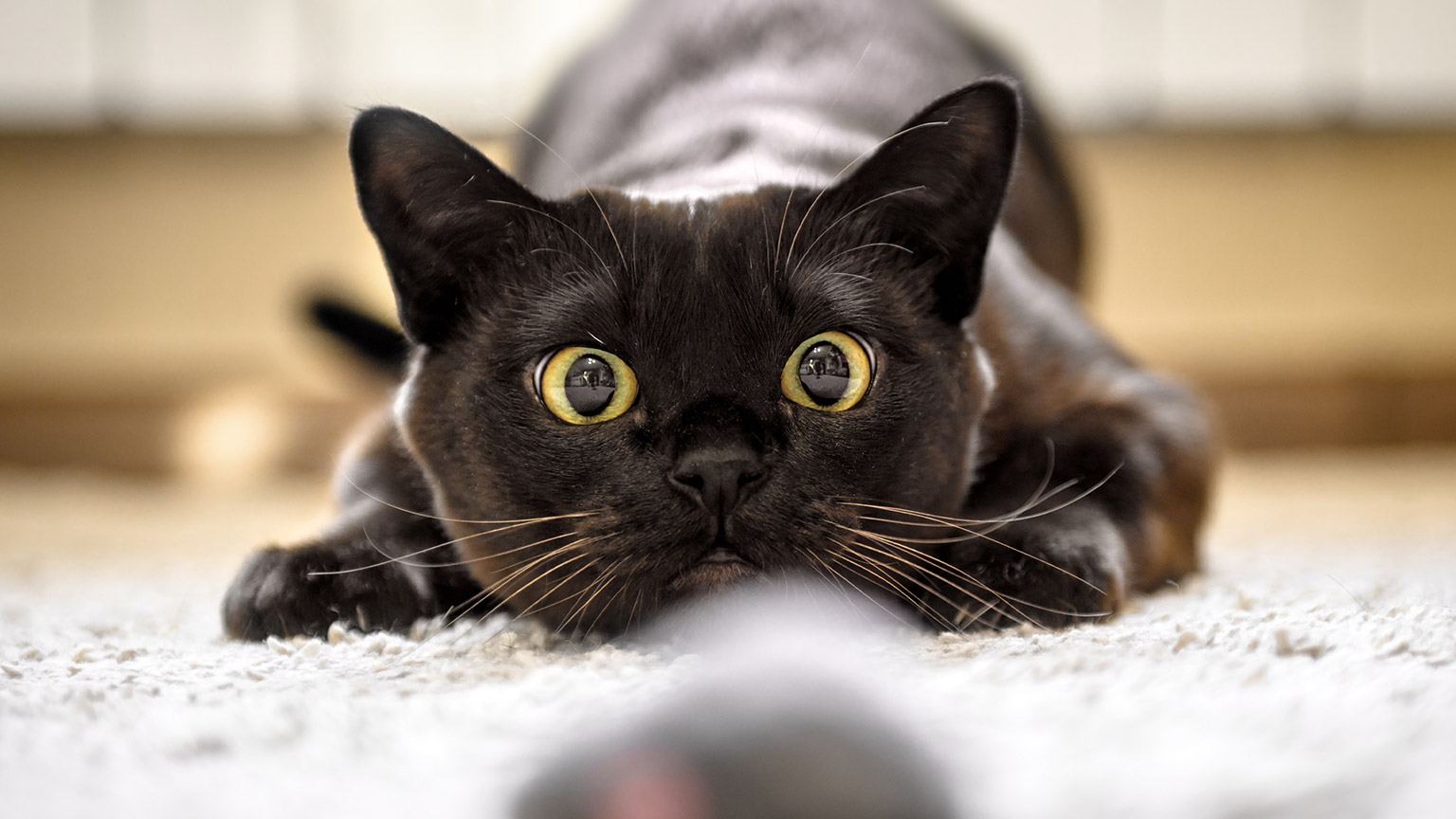Kia ora koutou animal lovers! We’re delighted to welcome you to Module Three – Animal Husbandry, Behaviour, Handling and Transportation. This course is where it’s at when working with companion animals – you’ll learn all about the daily handling and care that they need, and also how to transport them in a safe and stressless way. Even better, in this module you can start putting into practice some of the skills you have been learning about.
This course will equip you with basic knowledge on providing animals with appropriate care, so they are free from injury and do not suffer from unnecessary pain, fear, or stress. We will be looking at:
- Animal movement, body language, behaviours, temperaments and unusual behaviours
- Approaching, handling and transporting animals
- Grooming
- Feeding, watering and enrichment
- Daily welfare
This module is the heart of this programme, and we know you’ve waiting patiently for it. Let’s begin!
| Credits | 25 |
| Learning Hours | 250 |
| Learning Outcome | LO3.1 Apply effective handling and transportation of companion animals in an animal care and welfare setting LO3.2 Describe day to day care of companion animals in an animal care and welfare setting LO3.3 Apply handling and husbandry techniques to assist day-to-day care of companion animals |
| Assessment | ANML03A1 |
You are free to plan your studies in the way that works best for you, but we know that guidance on how to do this is also helpful. We suggest following way to navigate through the learning content over the next few weeks:
| Week 1 | Topic 1 |
| Week 2 | Topic 2 |
| Week 3 | Topic 3 |
| Week 4 | Topic 4 |
| Week 5 | Topic 5 |
| Week 6 | Topic 6 |
| Week 7 | Topic 7 |
| Week 8 | Topic 8 |
| Week 9 | Topic 9, assessment preparation and practicals |
| Week 10 | Topic 9, assessment preparation and practicals |
| Week 11 | Topic 9, assessment preparation and practicals |
| Week 12 | Topic 9, assessment preparation and practicals |
Important Note on your Work Placement and Assessment 03A1
It is recommended that you start your 40 hours of work placement in Module Three. This will be important as part of the assessment for this module has a practical component that requires handling of cats, dogs and one of rabbits, rodents and birds.
We recommend that you:
- Download and read assessment 03A1 now
- Check you have completed the steps for putting your Training Agreement/s in place (See instructions in Course Overview)
- Talk to your work placement supervisor about planning for the practical part of the assessment
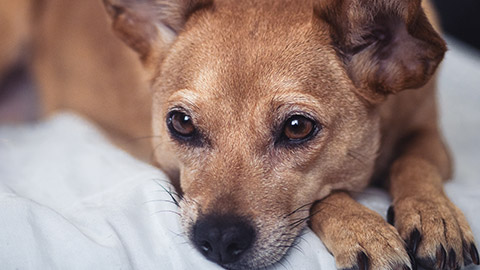
An animal’s eyes have the power to speak a great language.Martin Buber, Philosopher.
Animals have natural or instinctive behaviours that are called movement behaviours. These behaviours can be periodic. For example, daily foraging (looking for food) behaviours or yearly migration (moving from one place to another) behaviours. Movement behaviours may also change depending on the climate, season (which may include times of the year mating occurs), and changes in the environment or ecosystem.
Movement behaviours can also be seen in domesticated animals but look different from those in the wild. For example, domestic animals would not migrate in the change of season. This also applies to captively held animals, although some behaviours in captively held animals will be encouraged or remain unchanged. For example, nocturnal animals would still sleep during the day.
Animal behaviour is the animal's coordinated response to internal and external environmental influences or stimuli.
Normal behaviours are responses to stimuli that humans consider typical for an animal and aren’t undesirable. When considering if a behaviour is normal for an animal, it is important to consider the context, intensity, and frequency of the behaviour.
For example, a dog barking during play would be considered normal but a dog constantly barking during the night would be considered undesirable. A cat licking its paw after it stepped on a spike would be considered normal but a cat that continually licks and bites at its paw causing trauma would be considered undesirable.
Underlying Motivations
Animal behaviour has an underlying motivation as to why the animal is performing them. These motivations may be:
- the animal is feeling scared
- the animal is very hungry
- the animal wants company
- the animal is unsure or anxious.
Motivations do not include things like:
- the animal does not like me
- the animal was feeling spiteful.
Undesirable Behaviours
It is also important to consider the species or breed of the animal when looking at behaviours. Some behaviours can be normal for the species but undesirable for the owner. For example, a cat scratching at furniture is normal but undesirable for the owner. In these situations, enrichment opportunities can resolve these undesirable behaviours. Introducing a cat scratch pole can stop the cat from scratching furniture in the house.
Undesirable behaviours are the responses to stimuli that humans find annoying or are unwanted by the human. It does not mean that this behaviour is abnormal. Different animals will display different types of undesirable behaviours.
So, what are undesirable behaviours?
Separation anxiety
When dogs are separated from their owners, they may display signs of separation anxiety. These behaviours include excessive barking, destructive behaviours, inappropriate urination, hypersalivation, or attempts to escape. Separation anxiety is linked to an animal’s dependency on its owner.
Tail chasing
Tail chasing falls under obsessive-compulsive disorders and is when the dog continually runs in a circle trying to catch its tail. Sometimes, if the dog succeeds in catching its tail, it may start to chew or self-mutilate the tail.
Vocalisation
This is when an animal is excessively vocal and may be considered a nuisance. This may be from boredom, stress, or fear. This can be seen in companion animals such as cats and dogs.
Food or resource guarding
Food or resource guarding is commonly seen in companion animals, specifically dogs. This is when the animal displays behaviours so that it can control who and what has access to an object or food. This can also be seen with owners; dogs can become possessive over their owners. Dogs displaying guarding behaviours are often displaying aggressive body language. This could be growling, barking, or snapping.
Noise anxiety
Animals often display signs of fear or stress around loud noises. Noise-related anxiety may be triggered by things such as fireworks, thunder, or gunshots. This is commonly seen in dogs. During these episodes of anxiety, a dog may hide, try to escape, shiver, tremble, or bark excessively.
Self-mutilation
This is when an animal continually licks or bites an area of the body or in birds, plucking at their feathers. This can be seen in most species. For example, dogs, cats, mice, rabbits, and birds. Self-mutilation can be harmful as they often do not stop, which can lead to wounds and infections.
Destructive behaviours
Destructive behaviours can be seen in animals that are bored or have separation anxiety. Destructive behaviours can include chewing up toys or beds, ripping out plants, digging holes, or chewing at furniture. This can be seen in cats, dogs, rabbits, and birds.
Reading
Separation anxiety: How to help your dog get used to being alone again
This article from Stuff.co.nz is about anxiety in dogs and includes the sad story of border collie cross Teddy who fatally injured himself. His owner thinks that he had separation anxiety after his human family went back to work and school when Covid lockdowns ended.
Expected Duration: 10 minutes
Questions
Pre Read Question: Many dog experts think that separation anxiety is very common. Take a guess before you read: what percentage of companion dogs do you think suffer from separation anxiety? Write down your guess and then compare it with the information in the article.
URL: Separation anxiety: How to help your dog get used to being alone again | Stuff.co.nz
Post Read Task: Make notes for your own reference on the useful suggestions for managing separation anxiety in dogs.
Temperament typically refers to the attitude, mood, or behaviour of a person or animal. For example, if you were looking to adopt a dog, you may be leaning towards a dog with a sweet or friendly temperament rather than a vicious or aggressive temperament.
Animals can have different temperaments and it is important to consider this when handling and restraining animals. The animal's body language may help you determine the animal’s temperament.
You may also see temperament referred to as personality, disposition, or coping style.
Different breeds may have a predisposition to a certain temperament. This is often linked to the group that they belong to.
For example, Border collie temperaments are closely linked to their jobs as herders. Border collies are also typically playful and have lots of energy. Whereas a chihuahua is typically feisty but loving and loyal to its owners. They are also known to be confident and courageous.
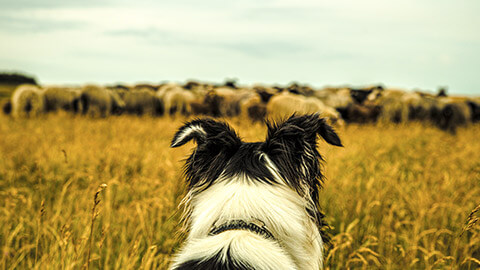
Case Study
Kai explains why they wanted Dutch Rabbits
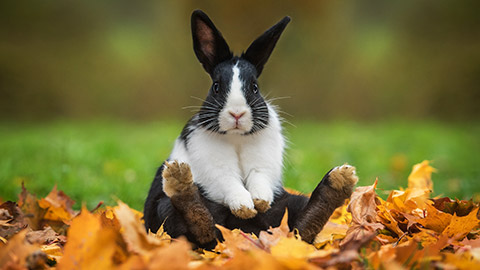
I’ve always loved rabbits, even as a small child. Because both Mum and Dad at one time or another worked in jobs where we moved house a lot, I wasn’t able to have pets when I was younger. It’s different now, as my parents finally bought a house and don’t want to move anymore. But I did have to convince them that rabbits actually make great indoor pets.
At first I was keen on Flemish Giants, but like the name says they get pretty big. My dad is a neat freak and wasn’t keen on any of the long-haired breeds because he didn’t want the fur getting everywhere. I wouldn’t have minded all of the brushing that they require though as angora rabbits are so pretty.
In the end, I decided that Dutch Rabbits are the way to go. They are popular rabbits to have as pets as they are small, and their temperament is usually gentle, calm and friendly. Dutch Rabbits are regarded intelligent and easy to train, which was important to me as they needed to be well-behaved so my parents wouldn’t be annoyed. They are curious and playful rabbits and can get up to mischief sometimes though, but I didn’t tell my parents that!
One of the key reasons I decided to get Dutch Rabbits is that they thrive on attention, which works really well for me and my anxiety. I spend a lot of time with Freya and Ravenna, and it doesn’t cause them any stress and the interaction is good for me as well. I really recommend them if you are looking for companion rabbits in your life.
Activity
What’s the temperament of a companion animal in your life? Write a short description of its temperament as you experience it, and then do some research on the breed or type of your companion animal. Does what you wrote match the general temperament of the breed or type? Share your answers in the forum. Don’t forget to comment on other people’s posts as well!
Animals can communicate with us in a variety of ways using their ears, eyes, mouth, tail, posture and even how their fur is sitting. This is known as body language and is a little different for each companion animal. Let’s take a look at the body language of cats and dogs.
Body Language - Dogs
Common, basic body language seen in dogs include:
- Happy
- Playful
- Content
- Relaxed
- Stressed or unsure
- Submissive
- Anxious
- Frightened
- Terrified
- Fearful
- Aggressive
Always remember:
- A dog with a wagging tail does not mean they are happy or friendly. You need to pay attention to the tail action.
- A dog that is yawning can indicate the dog is stressed not that they are tired.
Have you heard about Bunny the dog?
Bunny is a Sheepadoodle who is part of study called ‘TheyCanTalk’ where animals are trained to use electronic word boards to communicate with their humans. Bunny has great body language, but as you will see in the video below she also seems to be able to communicate using human words. Bunny has a whole YouTube channel which you might enjoy exploring.
Body Language - Cats
Common, basic body language of cats includes:
- Relaxed/Friendly
- Fearful
- Frightened
- Aggressive (This can be either defensive or offensive)
Cats also use their body language to show affection. Signs of affection include:
- Slow blinking
If a cat is gently blinking it indicates love and trust. - Purring
This indicates happiness and contentment. - Rubbing against you
This is when a cat rubs against your legs or body using its face, cheeks, or gums. During the rubbing, the cat is sharing their scent with you and declaring you family. - Vocalisation (Meowing)
Meowing can mean several things, but it is a way of getting your attention and asking for some affection. - Head bunting
This is a universal cat greeting for loved ones and is a bonding ritual. It is like humans giving each other a big hug.
Reading
Cats have nearly 300 facial expressions
A recent study has shown that cats may have up to 300 facial expressions that they use to communicate with each other.
Expected Duration: 5 minutes
Questions
Pre Read Question: Do you think dogs also have up to 300 facial expressions? Make a note of what the article says as you read.
URL: https://www.science.org/content/article/cats-have-nearly-300-facial-expressions
Post Read Task: What was one of the suggested reasons given in the article for why cats have so many different facial features? Complete the following activity to check your recall.
Don’t make Billi mad!
Billi is a domestic cat who is also part of the same ‘TheyCanTalk’ study as Bunny the dog. One of Billi’s favourite words to use is ‘mad’, which doesn’t seem that surprising given that cats are famous for their often-angry body language. Billi also has a YouTube channel and a website where you can see how she ‘talks’ with her human. Check it out here: https://www.billispeaks.com/about-us
Activity
What are your thoughts on animal body language and communication? Did what you saw of Bunny and Billi make you think that animals can communicate with us using more than just body language? Share your ideas in the forum.
Activity
Find out about the body language of rabbits, birds, rats and mice and make notes for yourself in the activity below. You will be able to save them as a pdf and download them to your device for your own records.
Many risks and hazards can be associated with an animal’s behaviour and temperament. It is extremely important to always observe an animal at a distance, to get an understanding of its behaviour, body language, and temperament. Communication is also extremely important when it comes to animal behaviour and temperament. Always ask a client or owner what their animal is normally like with people and other animals, this will give you an insight into what they are like and the precautions you need to take. For example, if an owner advised that their dog is normally dog aggressive, you may decide to house the animal in a quiet room where there are no other dogs.
Whilst the animal is in your care, it is important to update their record and place warnings/notes on their cage when you observe certain behaviours. For example, if an animal were to become aggressive or you noticed they were growling when you came near the cage, it would be appropriate to put a caution sign on the cage.
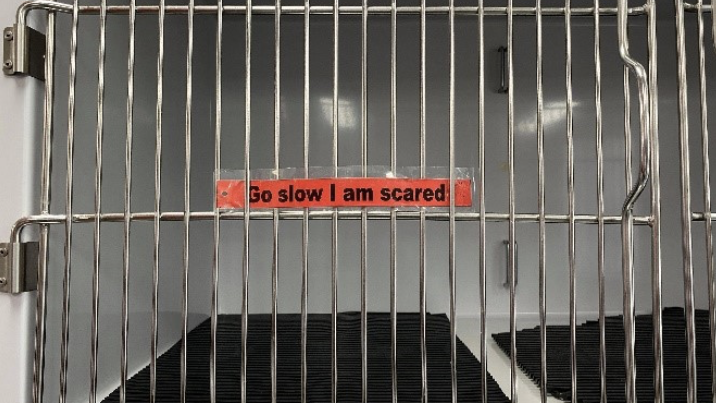
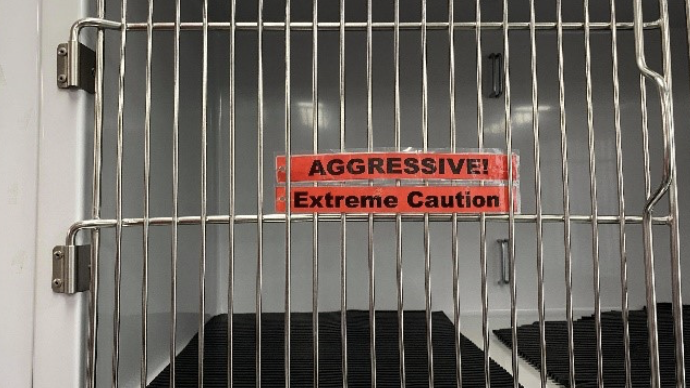
Some risks and hazards can include:
- animal bites
- scratches
- kicks
- crush injuries.
Activity
Let’s review what we have just covered about animal motivation and behaviour.
Now that we have talked about basic animal behaviour we are ready to think about how behaviour affects how we handle and interact with animals. Time to begin Topic Two – Animal Behaviour and Handling.
